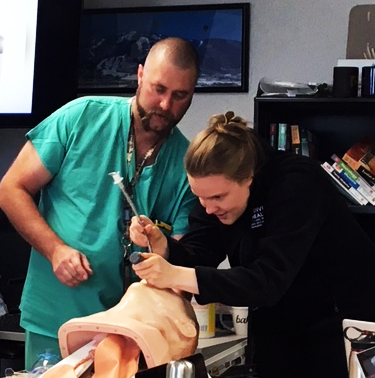All Hands on Deck
Fourth-year medical students answer the call for help during COVID-19 surge
By Tyler Smith
(April 2021) A tick before 7 p.m. on November 25 – the day before Thanksgiving – Shanta Zimmer, MD, pushed the “send” button on an email that sounded a call to arms against an enemy that was gathering strength.
The foe was the novel coronavirus, which was rapidly spreading throughout Colorado and sending fresh waves of patients sickened with COVID-19 to hospital beds.
Zimmer, an infectious disease specialist at UCHealth University of Colorado Hospital, saw the strain on staff with her own eyes. The number of patients hospitalized with COVID-19 had climbed rapidly since September. Two weeks earlier, Gov. Jared Polis told hospitals across the state to submit plans to increase capacity by 50%.
Zimmer was in position to call for help.
As senior associate dean for education at the University of Colorado School of Medicine, she oversees the preparation of more than 700 medical students. Her email went to fourth-year students who were busy scheduling
residency interviews. Zimmer requested volunteers to take two 10- to 12-hour shifts, either on medical/surgical floors or the surge ICUs, from November 30 to December 5.

Katie Havranek, shown here practicing intubation, is one of many CU medical students who volunteered to help support hospital providers caring for COVID-19 patients. Photo courtesy of Katie Havranek.
Urgent need for help
Attending physicians, residents, hospital medicine specialists, and advanced practice providers at UCH badly needed assistance with patient care, Zimmer wrote: “We are entering the ‘all hands on deck’ phase of the crisis here in the Denver area.”
She attached two documents describing the support students would be asked to provide: placing orders, contacting family members, documenting care, tracking lab results, and more. They would function as clinical team members under the supervision of faculty and residents. She emphasized that they were under no obligation to volunteer.
Zimmer awoke Thanksgiving morning to find that the students had filled all the available shifts for the week. The surge continued that week – without any sign of abating – so on Friday, December 4, Zimmer asked again for volunteers, this time to fill shifts for the rest of December and all of January. By the following Monday, the students had filled all of those shifts, including Christmas Eve and Christmas Day.
“People say a lot of things about the next generation and are they going to be committed and are they altruistic – all those kinds of things,” Zimmer said. “I want people to know they are. You can count on the next generation of physicians who are coming out.”
A desire to pitch in
Katie Havranek answered Zimmer’s request. She welcomed the chance to volunteer – particularly because the capacity pressures created by the first wave of the COVID-19 pandemic in March and April 2020 forced the hospital to set aside teaching temporarily and bumped Havranek and her fellow students out of their clinical rotations.
“Going into medicine, most of us are compelled to help people,” Havranek said. “In our fourth year, we feel a sense of belonging and responsibility to our communities, our patients, and other physicians.”
During hiatus from direct patient care in the spring 2020, Havranek and many of her fellow students found other ways to help. She gathered personal protective equipment for the hospital and worked with others to distribute cards recognizing staff for their service.
After that first surge subsided, Havranek completed a clinical rotation caring for COVID-19 patients in intensive care units.
Medical students help COVID-19 patients
As a result, she was well-prepared to provide clinical support in November and December. Havranek joined teams that included an attending physician, an intern, and two residents. For each shift, she was assigned a patient and presented the case to the attending physician during rounds. She wrote notes that a resident edited for review by the attending.
Havranek also managed volunteer shifts and fielded feedback from other volunteers. Those insights made assignments more flexible – volunteers might switch from one unit to another depending on needs during a particular shift – and bolstered documentation for calling families of COVID-19 patients.
Though she worried about encumbering the team, that wasn’t an issue. “They are always very generous teachers,” she said. Despite the mounting stress of the pandemic, “I’ve never encountered anyone not excited to teach.”
Jean Kutner, MD, chief medical officer for UCH, added a note of praise and gratitude for the students’ commitment to relieving stress on hard-pressed providers, patients and families.
“We got a great response from the fourth-year medical students, who have become members of teams and provided support,” Kutner said. “It shows the strength of an academic medical center.”
These days, Zimmer said she occasionally encounters one of the student volunteers when she sees a patient in her role as an infectious disease specialist. She’s gratified to see them working as an integral member of a clinical team.
“I see these students of mine as colleagues, and I let them know that I see them that way,” Zimmer said. “There is an understanding that they are now part of the profession of medicine. That gives me an immense sense of pride.”
This article was originally published in UCHealth Today in December 2020.